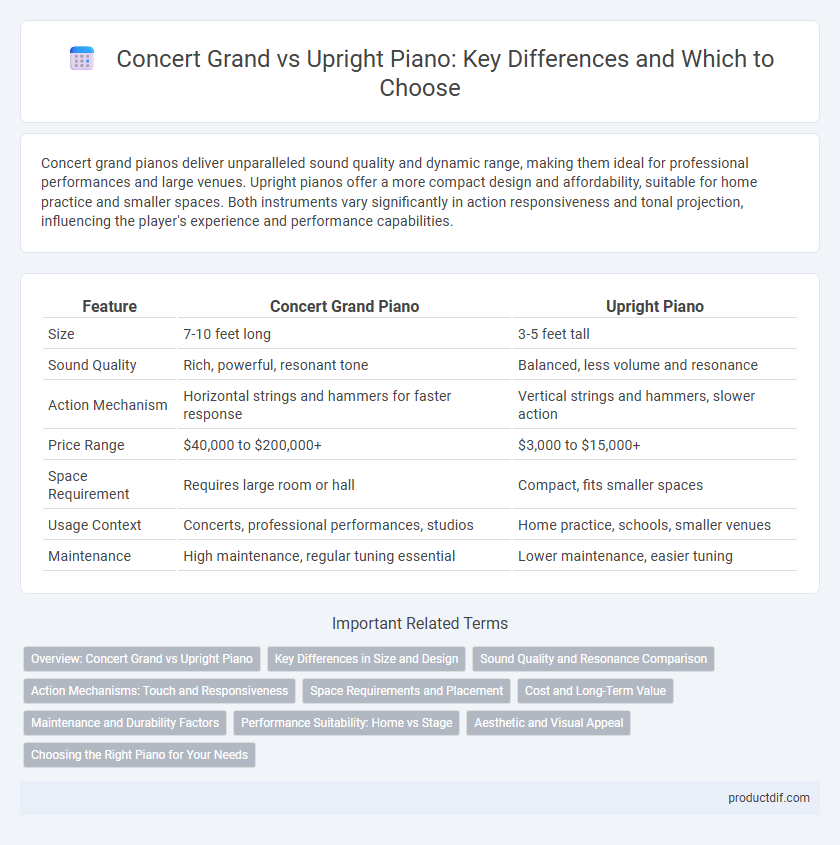Concert grand pianos deliver unparalleled sound quality and dynamic range, making them ideal for professional performances and large venues. Upright pianos offer a more compact design and affordability, suitable for home practice and smaller spaces. Both instruments vary significantly in action responsiveness and tonal projection, influencing the player's experience and performance capabilities.
Table of Comparison
| Feature | Concert Grand Piano | Upright Piano |
|---|---|---|
| Size | 7-10 feet long | 3-5 feet tall |
| Sound Quality | Rich, powerful, resonant tone | Balanced, less volume and resonance |
| Action Mechanism | Horizontal strings and hammers for faster response | Vertical strings and hammers, slower action |
| Price Range | $40,000 to $200,000+ | $3,000 to $15,000+ |
| Space Requirement | Requires large room or hall | Compact, fits smaller spaces |
| Usage Context | Concerts, professional performances, studios | Home practice, schools, smaller venues |
| Maintenance | High maintenance, regular tuning essential | Lower maintenance, easier tuning |
Overview: Concert Grand vs Upright Piano
Concert grand pianos feature larger soundboards and longer strings, producing richer tones, greater volume, and enhanced dynamic range compared to upright pianos. Upright pianos are designed with vertical strings and smaller soundboards, making them more compact and suited for limited spaces without compromising basic tonal quality. The action mechanism in concert grands offers superior responsiveness, making them the preferred choice for professional performances and advanced pianists.
Key Differences in Size and Design
Concert grand pianos typically measure 7 to 10 feet in length, featuring horizontal strings and a large soundboard that deliver powerful, rich tones ideal for professional performances. Upright pianos, standing about 3 to 5 feet tall, have vertical strings and a compact design that conserves space, making them suitable for home use. The structural differences between concert grand and upright pianos significantly impact sound projection, tonal quality, and overall aesthetic presence.
Sound Quality and Resonance Comparison
Concert grand pianos produce superior sound quality and richer resonance due to their larger soundboards and longer strings, allowing for greater dynamic range and harmonic complexity. Upright pianos have more compact soundboards and shorter strings, resulting in less resonance and a more muted tone. The placement of the strings vertically in uprights reduces sound projection compared to the horizontal string layout in concert grands.
Action Mechanisms: Touch and Responsiveness
Concert grand pianos feature a horizontal action mechanism that allows hammers to return to their resting position under gravity, providing faster repetition and greater control for nuanced touch. In contrast, upright pianos utilize a vertical action system where springs assist hammer return, typically resulting in slower responsiveness and less precise dynamic control. The concert grand's action mechanism supports superior tactile feedback, essential for advanced expressive playing.
Space Requirements and Placement
Concert grand pianos demand significant space, typically requiring an area of at least 9 feet in length and ample width to accommodate the instrument's large, horizontal frame and lid clearance. Upright pianos have a compact vertical design, making them ideal for smaller rooms or tight spaces, often needing only about 2 feet of depth and fitting neatly against walls. Placement for concert grands favors open, acoustically treated spaces to maximize sound projection, while upright pianos can be placed in more confined spaces with less impact on acoustics.
Cost and Long-Term Value
Concert grand pianos, with prices ranging from $70,000 to over $200,000, represent a significant investment but offer unmatched sound quality and durability that can increase in value over time. Upright pianos typically cost between $3,000 and $12,000, making them more accessible upfront but generally hold less resale value and offer a shorter lifespan. For serious musicians or institutions prioritizing long-term value and rich tonal quality, a concert grand piano provides a more worthwhile financial commitment despite the higher initial cost.
Maintenance and Durability Factors
Concert grand pianos require regular tuning and regulated maintenance due to their complex action and larger soundboard, ensuring optimal sound quality and longevity. Upright pianos, while generally more durable with lower maintenance demands, may experience faster wear in their vertical action mechanisms and require periodic voicing and regulation to maintain performance. Proper environmental control, such as humidity and temperature stability, significantly impacts the durability and maintenance frequency of both concert grand and upright pianos.
Performance Suitability: Home vs Stage
Concert grand pianos deliver superior sound projection and dynamic range, making them ideal for large stage performances and professional concerts. Upright pianos, with their compact design and moderate sound output, are best suited for home use and practice environments. Choosing between them depends on space availability, acoustic needs, and the intended performance setting.
Aesthetic and Visual Appeal
Concert grand pianos showcase an impressive, sleek design with extended ebony or polished wood finishes that exude sophistication and luxury in any performance setting. Upright pianos offer a more compact structure, blending functionality and style ideal for smaller spaces without sacrificing classic charm. The visual appeal of concert grands often elevates stage presence, while upright pianos complement home decor with versatile elegance.
Choosing the Right Piano for Your Needs
Concert grand pianos deliver unparalleled sound quality with expansive tonal range and powerful projection, ideal for professional performances and large venues. Upright pianos offer space-efficient design and affordability, making them suitable for home practice and smaller spaces without compromising essential sound characteristics. Selecting the right piano depends on balancing performance requirements, available space, and budget constraints to meet individual musical goals.
Concert grand vs Upright piano Infographic

 productdif.com
productdif.com